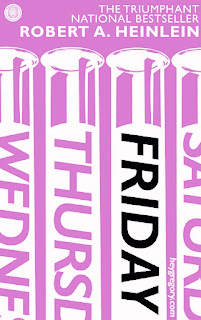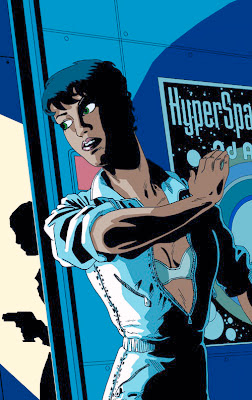November is National Novel Writing Month (officially and henceforth to be called
Nanowrimo). The goal of the project is to bang out 50,000 words in 30 days. When it began in 1999, it boasted 21 participants. Last year, it had 256,618. I've followed friends via social networks as they've toiled on their stories, posting daily word counts and venting their frustrations. I like the idea, but November is when I start the scaffolding of the following year's comic, so I can't do it. At least I'm writing
something.
This year, as the month and contest again crept up, I considered how I could do something in solidarity with my writing buddies. If nothing else,I would hand out some Gatorade as they chug through the marathon. Then I wondered about running my own obstacle course in another medium. If I can't write a novel, maybe I could in some way illustrate it. An adaptation? No, much too big. But making a new cover for an existing novel ... I could do that. And I knew exactly what book needed it most.
I picked up Robert Heinlein's
Friday in college. I was dating a girl who seemed to always be reading his works yet couldn't give a detailed answer when I asked about the appeal. In fact, she said exactly three words: "well, there's sex ..." And that was it. If you had asked me at the time why I read, say, X-Men, you would have left the room before I paused my babble to breathe. Despite this vague response, (it begs the question
so why this guy's works instead of Henry Miller or a Harlequin novel), I picked up a Heinlein book and gave it a read, and discovered that, no actually, not so much with the sex. More like constant flirting and groping. There are no choreographed sex scenes. In fact, the "camera" cuts way and returns right before and right after the deed, but you're gonna get "deed" about every ten pages. Don't dive for a book looking for panting and acrobatics. You won't find it.
ASIDE: If you decide to try Heinlein, do not do what I did and unknowingly pick up a book steeped in recurring time traveling characters with multiple names who appear in multiple books because, hokey smoke, you will be lost in the riptide.
Friday is a good start for his works after 1960. It's self-contained and a fine intro to the morals and politics of his later stories.
Job is good too. Maybe
I Will Fear No Evil. If you like any of those, then go to
Stranger in a Strange Land (unabridged) and work your way through chronologically.
I like
Friday because it's pulp. It's literary bar food. Think of it as a female James Bond or Remo Williams or
Mack Bolan. She's genetically engineered to be super capable, and she lethally chops a bad guy in the third sentence. Then you get little
Candide, a little
Huck Finn, a little
Fear of Flying, and a bit of Marvel Comics' X-Men, funny enough. (But not by accident,
X-Men writer Chris Claremont stole bunches of stuff from Heinlein. And
Power Pack is an outright theft of
Number of the Beast. Oh, and the name of that book's talking spaceship? Friday.)
I've read this book a lot. My long-lived paperback copy is yellowed and curled. I know the major and minor chords of this story fairly well. Which is why the cover art makes my eye twitch.
Lookee here:
This isn't the only cover art produced for the story. There are these:
But the Whelan art is on the copy I have, and that's why I'll focus on it as a launchpad.
I don't know what instructions cover artist Michael Whelan was given, but I doubt they included the character's description. Granted, we don't get a driver's license breakdown of characteristics in the book, but there two things very wrong here:
1) This image is darker than my book's cover, but that hair is blonde. Dirty blonde maybe, but blonde. Friday twice says "blond(e)s intimidate me."
2) She refers to her "built-in suntan" and says Tongans are "about as brown as I am." Google Tongans. Yeah. Later in the book, her gene influences are listed as "Finnish, Polynesian, Amerindian, Innuit, Danish, red Irish, Swazi, Korean, German, Hindu, English, and bits and pieces from elsewhere." Miss Feline Face Friday above looks like she'd sunburn sitting next to a banker's lamp.
Even the first time I read the book, I got about 60 pages before I wondered what the woman on the cover had to do with the title character.
In my head, she looks more like, oh, Mila Kunis.
As per the character's comments, however, she would have a hairdo closer to a bob or pageboy. Not much different from the cover art haircut, really.
Or if you think she might be a tad more suntanny, maybe Halle Berry.
Or, hey, remember FOX's
Dark Angel scifi series starring Jessica Alba? Wikipedia condenses it this way:
Set in a post-apocalyptic Seattle, the show chronicles the life of Max Guevara (X5-452), a genetically enhanced super-soldier, portrayed by Jessica Alba as an adult and Geneva Locke
as a child, who, after escaping from a covert government
biotech/military facility as a child, tries to lead some semblance of a
normal life and constantly tries to elude capture by government agents,
while searching for her genetically-enhanced brothers and sisters
scattered in the aftermath of their escape.
That has quite a bit in common with Heinlein's book. (Seattle is where Friday claims to be born, for example, because that city's destruction explains why she has none of the documentation of normal folks). So let's also look at Jessica Alba as the Dark Angel:
Cut the hair, and we've pretty much got Friday.
There's a little confusion later on regarding her height; she describes herself more than once as being the same size as a woman who is 10 centimeters (4 inches) shorter than her husband. The husband is eyeballed at 195 centimeters, making him more than six feet tall. But the wife and Friday are regarded later as much smaller than them, enough that neither could reach certain high objects their menfolk could. This is the nittiest of picks. Where the height might confuse the artist, the physiognomy shouldn't. The author is consistent there.
So, in brief, thus, and therefore, that cover art is wrong and wrong some more. I will now launch National Novel Cover Redesign Month (Nanocoremo) to fix this. I'm gonna make my own
Friday cover.
Let's start this with another criticism: Friday, a very active action hero, ain't doing jack on the Whelan cover. Again, no idea what his editor's instructions were. He or the author himself may have been very specific about what they wanted. But I consider the final product to be boring and, again, a thunderstorm of wrong.
The new cover should then have three elements:
1) A title character closer to the book's descriptions.
2) A little more energy. Even implied kinetic energy. Friday can kill with a Charlie's Angel judo chop. She's always mindful of the nearest exit and potential threat. She's also on the run for a good chunk of the book. Let's convey that.
3) Something scifi. The book is in the future, with a fractured Western hemisphere and space elevators and ballistic airplanes and finger watches. I'm OK with the porthole on the Whelan cover. It's a fine way to tell us this is science fiction.
When I think about the book, one scene comes to mind most often: Friday on the fantail of a steamboat headed up the Mighty Mississip'. My initial sketches went there.
Whelan gives us a denim jumpsuit straight out of the novel. That's it to a T, so I'll follow his design here. Maybe a few tweaks. But these sketches break my second required element: She's doing even less than on the Whelan cover. At least the first gal is
standing. I mean, yes, we're looking at a Friday in contemplation, as opposed to Whelan's somewhat dead-eyed cheesecake, but I can't see the gears whirring. Also, when I opened up my sketchbook a few hours atfer drawing the last image above, I was struck by this:
It's not a bad parallel for a conversation about the characters. They both feel like they don't belong. They both make an effort to earn their place among people not like themselves. But the similarity in images and my sketches' inertia killed the appeal for me. This is not our cover.
But we're getting there.

















































